
Workout for Fighters Using the Versapulley
By Corey Beasley
I am always looking for new ways to keep my fighters healthy and improve their athletic performance. Several years back, we were introduced to the Versapulley and instantly saw value. It is unlike any other machine we have used and it fills a gap left by traditional weight training. I see my fighters twice per week and we typically lift heavy one day and then do more dynamic work on the next. Below is one example of a dynamic workout for fighters, using the Versapulley.
Versapulley Workout for Fighters
Workout Summary
- Hand Supported Split Squat - 5 reps per leg, 3 sets, 3 minutes rest between sets
- RDL - 5 reps, 3 sets, 3 minutes rest between sets
- Split Squat Row - 5 reps per arm, 3 sets, 3 minutes rest between sets
- Wood Chop w/ Weight Shift - 5 reps per side, 3 sets, 3 minutes rest between sets
*Explosive is the goal for this sample workout... the digital read out makes it easy to monitor the output of each rep.
Note: By adjusting the load, reps, sets, rest and other variables, we can customize each workout to fit the specific goals. This allows you to adjust your workouts and improve the full spectrum of the force velocity curve. For example, we may 'load up' the flywheel and build strength, when we are out of camp...but will slowly reduce the load (increasing power/speed) as we get closer to competition. Learn more about developing an mma workout schedule here.
Learn More About the VersaPulley
Click Here to Download the Versapulley White Paper
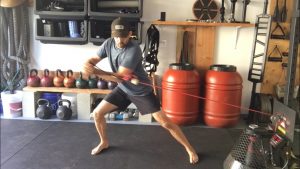 The goal of every training program is to decrease injury potential and improve performance. Additionally, rehabilitation and reconditioning programs strive to return the athlete to play in the quickest and safest manner possible, all the while reducing the likelihood of that athlete becoming re-injured.
The goal of every training program is to decrease injury potential and improve performance. Additionally, rehabilitation and reconditioning programs strive to return the athlete to play in the quickest and safest manner possible, all the while reducing the likelihood of that athlete becoming re-injured.
All of the highly-regarded practitioners in training, rehab, and reconditioning will agree that while it’s important to train concentrically for strength, power, speed, and explosiveness, they will also tell you that a large emphasis must be placed upon the breaking or deceleration of this newly acquired strength, power, speed, and explosiveness – this is where training eccentrically comes into play.
In most team sports, players are required to repeatedly perform short, explosive, efforts such as accelerations and decelerations during change of direction (1).
In the quest for enhanced speed and maneuvering in multiple planes, strength and power training programs typically make use of weights. While offering constant concentric and eccentric load in exercises emphasizing vertical actions, they rarely encompass horizontal/lateral actions offering eccentric overload (2).
Additionally, since strain injuries occur when muscle and tendon fibers cannot maintain the tension placed upon them and are disrupted (3), a program lacking a significant emphasis on eccentric training exposes the athletes to a greater injury risk.
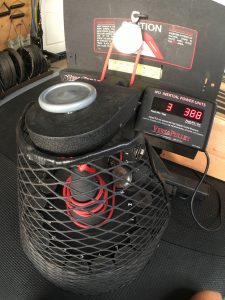 What are the benefits to strength, power, hypertrophy, and injury prevention when adding eccentric overload training? By adding something into our programs that we haven’t been doing, a significant increase in performance gains are seen. However that can be said about any strength-related stimulus. But what is the benefit of introducing eccentric training into your training program, and does that benefit far outweigh the cost of not doing so? – Lets see what the science says…
What are the benefits to strength, power, hypertrophy, and injury prevention when adding eccentric overload training? By adding something into our programs that we haven’t been doing, a significant increase in performance gains are seen. However that can be said about any strength-related stimulus. But what is the benefit of introducing eccentric training into your training program, and does that benefit far outweigh the cost of not doing so? – Lets see what the science says…
The higher forces generated and through eccentric training, have shown it to be a superior method in developing both strength and hypertrophy (3). Because it’s more effective than concentric training at increasing total and eccentric strength (3), it should be used to enhance the effects of the typical training seen within most weight rooms around the world. Studies have shown that eccentric overload training is superior to eccentric under-load in its ability to stimulate increases in strength4, but even more significant was the speed in which training adaptations took place. When compared to traditional concentric/eccentric training, eccentric overload was the only training regimen to increase lower-body lean muscle mass and show improvement in bone mineral density after only 8-weeks of similar training (4).
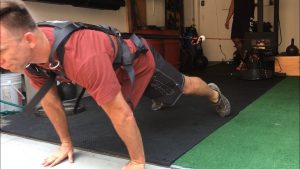 Further studies examining eccentric overload training and its effects on muscle hypertrophy showed similar effects (5-11). Eccentric overload training provides a sufficient hypertrophic stimulus for which gains can be realized in a shorter period of time compared to more traditional 1:1 exercise training (4). Greater hypertrophy was also reported following chronic resistance training comprising coupled eccentric and concentric actions or eccentric actions compared with concentric actions only (12-15) – this is another reason why utilizing eccentric overload training in conjunction with traditional weight training should be heavily considered. Put simply, greater muscle hypertrophy is a result of enhanced protein synthesis, which is a product of higher mechanical loading of the muscle. This type of mechanical loading is created by eccentric muscle actions (15).
Further studies examining eccentric overload training and its effects on muscle hypertrophy showed similar effects (5-11). Eccentric overload training provides a sufficient hypertrophic stimulus for which gains can be realized in a shorter period of time compared to more traditional 1:1 exercise training (4). Greater hypertrophy was also reported following chronic resistance training comprising coupled eccentric and concentric actions or eccentric actions compared with concentric actions only (12-15) – this is another reason why utilizing eccentric overload training in conjunction with traditional weight training should be heavily considered. Put simply, greater muscle hypertrophy is a result of enhanced protein synthesis, which is a product of higher mechanical loading of the muscle. This type of mechanical loading is created by eccentric muscle actions (15).
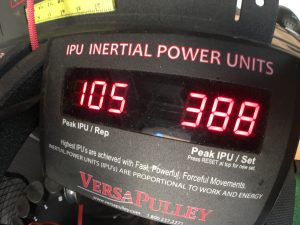 From a power development and application of force vantage point, higher muscle forces can be produced during eccentric contractions compared with concentric(3). And while all types of training can improve power in multiple planes of movement, the specificity of training adaptation principle mainly prevails (9). One particular study examined this specificity by programming exercises in both the vertical and horizontal plane. The results are likely what you would expect. Those who trained vertically improved in all planes, but made the most gains vertically (vertical jump), and those who trained multi-directionally also improved across the board, but gained the most multi-directionally (acceleration and change of direction (9). Research from 2016 indicated that those who train using eccentric overload were able to produce a significantly greater breaking and propulsive contact time (10). This suggests that eccentric overload could be a fundamentally important mechanism underpinning change of direction ability (16).
From a power development and application of force vantage point, higher muscle forces can be produced during eccentric contractions compared with concentric(3). And while all types of training can improve power in multiple planes of movement, the specificity of training adaptation principle mainly prevails (9). One particular study examined this specificity by programming exercises in both the vertical and horizontal plane. The results are likely what you would expect. Those who trained vertically improved in all planes, but made the most gains vertically (vertical jump), and those who trained multi-directionally also improved across the board, but gained the most multi-directionally (acceleration and change of direction (9). Research from 2016 indicated that those who train using eccentric overload were able to produce a significantly greater breaking and propulsive contact time (10). This suggests that eccentric overload could be a fundamentally important mechanism underpinning change of direction ability (16).
As with velocity based training, adaptations gained via eccentric training are highly specific to the velocity and type of contraction (3). This means that along with the programming, the method and device used are both critical to the outcome.
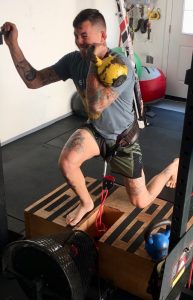 As an alternative to the traditional and ballistic training methods currently employed, are flywheel inertial devices. Their increasing benefits and contribution to training are continually being substantiated in scientific research (7,15,17-25), and are being incorporated into regular training programs. The benefits of this device include eliciting a greater overall amount of muscle activity than traditional overload exercises (15), and the ability to freely move in the multiple planes for a “specific” training stimulus (26-28). Additionally, the stimulus provided by employing flywheel devices may provide a more potent hypertrophic exercise stimulus than gravity-dependent weights (15).
As an alternative to the traditional and ballistic training methods currently employed, are flywheel inertial devices. Their increasing benefits and contribution to training are continually being substantiated in scientific research (7,15,17-25), and are being incorporated into regular training programs. The benefits of this device include eliciting a greater overall amount of muscle activity than traditional overload exercises (15), and the ability to freely move in the multiple planes for a “specific” training stimulus (26-28). Additionally, the stimulus provided by employing flywheel devices may provide a more potent hypertrophic exercise stimulus than gravity-dependent weights (15).
While any flywheel device will allow anyone to train at any point (eccentrically and concentrically) along the force/velocity curve, most allow for only vertical movement. Developing eccentric strength in multiple planes and at multiple loads allows for grater performance and injury prevention gains.
Perhaps one of the most overlook benefits to eccentric training is metabolic expenditure of performing these types of exercises. Eccentric contractions produce less fatigue and are more efficient and lower metabolic cost compared with concentric contractions (3).
One of the more known and perceived negative aspects of eccentric training is the acute performance decrement it can create if programmed incorrectly. Unaccustomed eccentric contractions produce transient muscle damage, soreness and force impairments (3). However, when duration, frequency and intensity of the eccentric training sessions are progressively increased, muscle damage can be minimized and even avoided, thus making eccentric muscle work a promising training strategy, not only to improve athletes’ performances, but also to help maintain or restore the exercise capacity (29-31). This protective benefit resulting from eccentric training is termed the repeated bout effect. This effect has been studied extensively in the research (32-40), and observed for years in the weight room.
Click Here to Visit the Versapulley Website
References:
- de Hoyo M, de la Torre A, Pradas F, et al. Effects of eccentric overload bout on change of direction and performance in soccer players. Int J Sports Med. 2015;36(4):308-314.
- Tous-Fajardo J, Gonzalo-Skok O, Arjol-Serrano JL, Tesch P. Enhancing change-of-direction speed in soccer players by functional inertial eccentric overload and vibration training. Int J Sports Physiol Perform. 2016;11(1):66-73.
- Roig M, O'Brien K, Kirk G, et al. The effects of eccentric versus concentric resistance training on muscle strength and mass in healthy adults: A systematic review with meta-analysis. Br J Sports Med. 2009;43(8):556-568.
- English KL, Loehr JA, Lee SM, Smith SM. Early-phase musculoskeletal adaptations to different levels of eccentric resistance after 8 weeks of lower body training. Eur J Appl Physiol. 2014;114(11):2263-2280.
- Walker S, Blazevich AJ, Haff GG, Tufano JJ, Newton RU, Hakkinen K. Greater strength gains after training with accentuated eccentric than traditional isoinertial loads in already strength-trained men. Front Physiol. 2016;7:149.
- Vikne H, Refsnes PE, Ekmark M, Medbo JI, Gundersen V, Gundersen K. Muscular performance after concentric and eccentric exercise in trained men. Med Sci Sports Exerc. 2006;38(10):1770-1781.
- Tesch PA, Ekberg A, Lindquist DM, Trieschmann JT. Muscle hypertrophy following 5-week resistance training using a non-gravity-dependent exercise system. Acta Physiol Scand. 2004;180(1):89-98.
- Ojasto T, Hakkinen K. Effects of different accentuated eccentric loads on acute neuromuscular, growth hormone, and blood lactate responses during a hypertrophic protocol. J Strength Cond Res. 2009;23(3):946-953.
- Mayhew TP, Rothstein JM, Finucane SD, Lamb RL. Muscular adaptation to concentric and eccentric exercise at equal power levels. Med Sci Sports Exerc. 1995;27(6):868-873.
- Hedayatpour N, Falla D. Physiological and neural adaptations to eccentric exercise: Mechanisms and considerations for training. Biomed Res Int. 2015;2015:193741.
- de Souza-Teixeira F, de Paz JA. Eccentric resistance training and muscle hypertrophy. Sports Medicine and Doping Studies. 2012;S1(004).
- Hather BM, Tesch PA, Buchanan P, Dudley GA. Influence of eccentric actions on skeletal muscle adaptations to resistance training. Acta Physiol Scand. 1991;143(2):177-185.
- Higbie EJ, Cureton KJ, Warren GL,3rd, Prior BM. Effects of concentric and eccentric training on muscle strength, cross-sectional area, and neural activation. J Appl Physiol (1985). 1996;81(5):2173-2181.
- Hortobagyi T, Zheng D, Weidner M, Lambert NJ, Westbrook S, Houmard JA. The influence of aging on muscle strength and muscle fiber characteristics with special reference to eccentric strength. J Gerontol A Biol Sci Med Sci. 1995;50(6):B399-406.
- Norrbrand L, Pozzo M, Tesch PA. Flywheel resistance training calls for greater eccentric muscle activation than weight training. Eur J Appl Physiol. 2010;110(5):997-1005.
- de Hoyo M, Sanudo B, Carrasco L, et al. Effects of 10-week eccentric overload training on kinetic parameters during change of direction in football players. J Sports Sci. 2016;34(14):1380-1387.
- Tous-Fajardo J, Maldonado RA, Quintana JM, Pozzo M, Tesch PA. The flywheel leg-curl machine: Offering eccentric overload for hamstring development. Int J Sports Physiol Perform. 2006;1(3):293-298.
- Romero-Rodriguez D, Gual G, Tesch PA. Efficacy of an inertial resistance training paradigm in the treatment of patellar tendinopathy in athletes: A case-series study. Phys Ther Sport. 2011;12(1):43-48.
- Pearson SJ, Harridge SD, Grieve DW, Young A, Woledge RC. A variable inertial system for measuring the contractile properties of human muscle. Med Sci Sports Exerc. 2001;33(12):2072-2076.
- Owerkowicz T, Cotter JA, Haddad F, et al. Exercise responses to gravity-independent flywheel aerobic and resistance training. Aerosp Med Hum Perform. 2016;87(2):93-101.
- Nunez FJ, Suarez-Arrones LJ, Cater P, Mendez-Villanueva A. The high pull exercise: A comparison between a versapulley flywheel device and the free weight. Int J Sports Physiol Perform. 2016.
- Norrbrand L, Tous-Fajardo J, Vargas R, Tesch PA. Quadriceps muscle use in the flywheel and barbell squat. Aviat Space Environ Med. 2011;82(1):13-19.
- Norrbrand L, Fluckey JD, Pozzo M, Tesch PA. Resistance training using eccentric overload induces early adaptations in skeletal muscle size. Eur J Appl Physiol. 2008;102(3):271-281.
- Fernandez-Gonzalo R, Irimia JM, Cusso R, Gustafsson T, Linne A, Tesch PA. Flywheel resistance exercise to maintain muscle oxidative potential during unloading. Aviat Space Environ Med. 2014;85(7):694-699.
- de Hoyo M, Pozzo M, Sanudo B, et al. Effects of a 10-week in-season eccentric-overload training program on muscle-injury prevention and performance in junior elite soccer players. Int J Sports Physiol Perform. 2015;10(1):46-52.
- de Hoyo M, Sanudo B, Carrasco L, et al. Effects of traditional versus horizontal inertial flywheel power training on common sport-related tasks. J Hum Kinet. 2015;47:155-167.
- Lohnes CA, Fry AC, Schilling BK, Weiss L. Kinetic comparison between various resistance settings on the versa-pulley training system. Medicine and science in sports and exercise. 2007;39(S):480.
- Young MA, Cook JL, Purdam CR, Kiss ZS, Alfredson H. Eccentric decline squat protocol offers superior results at 12 months compared with traditional eccentric protocol for patellar tendinopathy in volleyball players. Br J Sports Med. 2005;39(2):102-105.
- Isner-Horobeti ME, Dufour SP, Vautravers P, Geny B, Coudeyre E, Richard R. Eccentric exercise training: Modalities, applications and perspectives. Sports Med. 2013;43(6):483-512.
- Lindstedt SL, LaStayo PC, Reich TE. When active muscles lengthen: Properties and consequences of eccentric contractions. News Physiol Sci. 2001;16:256-261.
- LaStayo PC, Woolf JM, Lewek MD, Snyder-Mackler L, Reich T, Lindstedt SL. Eccentric muscle contractions: Their contribution to injury, prevention, rehabilitation, and sport. J Orthop Sports Phys Ther. 2003;33(10):557-571.
- Chen TC, Chen HL, Lin MJ, Wu CJ, Nosaka K. Muscle damage responses of the elbow flexors to four maximal eccentric exercise bouts performed every 4 weeks. Eur J Appl Physiol. 2009;106(2):267-275.
- Fernandez-Gonzalo R, Bresciani G, de Souza-Teixeira F, et al. Effects of a 4-week eccentric training program on the repeated bout effect in young active women. J Sports Sci Med. 2011;10(4):692-699.
- Howatson G, Van Someren K, Hortobagyi T. Repeated bout effect after maximal eccentric exercise. Int J Sports Med. 2007;28(7):557-563.
- Higino WP, Aparecido de Souza R, Cavalcanti Fde S, et al. Influence of repeated bouts of eccentric exercise on high-intensity aerobic performance. J Phys Ther Sci. 2016;28(8):2369-2372.
- Nosaka K, Newton M, Sacco P, Chapman D, Lavender A. Partial protection against muscle damage by eccentric actions at short muscle lengths. Med Sci Sports Exerc. 2005;37(5):746-753.
- Nosaka K, Sakamoto K, Newton M, Sacco P. How long does the protective effect on eccentric exercise-induced muscle damage last? Med Sci Sports Exerc. 2001;33(9):1490-1495.
- McHugh MP. Recent advances in the understanding of the repeated bout effect: The protective effect against muscle damage from a single bout of eccentric exercise. Scand J Med Sci Sports. 2003;13(2):88-97.
- McHugh MP, Pasiakos S. The role of exercising muscle length in the protective adaptation to a single bout of eccentric exercise. Eur J Appl Physiol. 2004;93(3):286-293.
- Paschalis V, Nikolaidis MG, Giakas G, Jamurtas AZ, Owolabi EO, Koutedakis Y. Position sense and reaction angle after eccentric exercise: The repeated bout effect. Eur J Appl Physiol. 2008;103(1):9-18.




